Brief Summary
EVC is Volvo Penta’s electronic engine control platform. EVC connects the engine, transmission, instruments and accessories in one and the same system. The result is high reliability, simple updates and access to smart accessories.
The technological leap forward, regardless of the application, is hard to ignore. Remember when your video re-orders went digital and suddenly you could watch any show on your drive, even if it was in the middle of a lineup? That’s thanks to thinking digitally. Now, we can reap the benefits of a digital world while piloting our boats thanks to Volvo Penta’s EVC, Electronic Vessel Control. It’s digital controllability for small boats, and it’s going to rock your world the same as the digital recorder took hold on land.
Key Features
- Drivability packages (twin engine installations)
Drivability main kit
- Powertrim Assistant
- Rudder indicator, sender, interface kit
- Joystick kit
- Joystick, software
- Electronic steering
- Docking station kit
- Joystick, software
- Electronic steering
- Economy packages (for twin engine installations)
Economy main kit
- Trip computer software
- NMEA 2000 interface
- Monitoring packages
Display kit (for twin engine installations)
- 7" color display
- Mounting kit
- Display kit (for single engine installations)
- 4" display
- NMEA 2000 interface
- Single Engine Packages
Aquamatic (sterndrive) single main kit
- Powertrim Assistant
- Trip Computer software
- Multisensor
Specifications
| Type of Engine | |
|---|---|
| Number of Cylinders | |
| Horse Power | 800 |
| Configuration | |
| Weight | |
| Fuel Type | Both (Gasoline or Diesel) |
| Fuel Delivery | |
| Shaft Length Options | |
| Shift Throttle Control | |
| Displacement | |
| Steering Control | |
| Recommended Fuel | |
| Alternator Output | |
| CARB Rating | |
| Engine Monitoring System |
Captain's Report
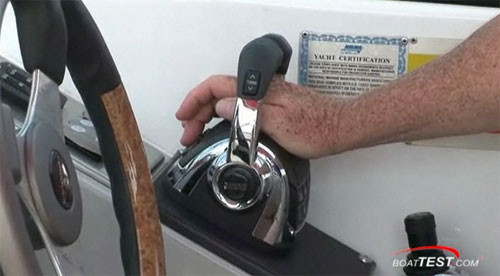 Capt. Steve Says….
Capt. Steve Says….Now I know what you’re thinking… “Too much technology on a boat is a bad thing around salt water”. Well that argument really doesn’t…er… hold water. Electronics have been around long enough to have pushed that long standing myth off a short pier, and as far as electronic controllability goes, well the engines on our boats have long ago been converted to electronic ignitions, and they are all still working just fine. So with all due respect to traditionalists, I have found that this digital technology that we are about to reap the benefits from, is a good thing, and hopefully by the end of this report, I’ll have you convinced of that as well. Having touched and felt the advantages first hand courtesy of Volvo Penta (the folks who introduced the world to pod drives you may recall), I am already convinced that this is the way to go.
The Simplicity
The first question we need to address is, “how does this technology work?” It’s a good question. The answer is, the system basically works by replacing the cables that you are used to using with electric servos that do the control work. In effect, you are no longer making a direct connection to, say, a throttle linkage. Now you are making a wired connection to the EVC (Electronic Vessel Control) brain, which distributes that signal to an electronic servo. The new digital engine control levers are now plug and play and, when moved in any direction, send a signal to the servos and the servo then moves the throttle linkage. The same happens with the shifting. You move the lever into gear and it engages a servo that moves the transmission linkage. An additional set of servos are connected to the outdrive trim as well. In a nutshell, that’s it!
So What?
So a lot! Now that there is an electronic signal between the linkage and the controls, you can add a boatload of functionality to that control input. It’s all a matter of how you want to manipulate that signal and what other functions you want to share that signal with. It’s an amazing marriage, and now that we’ve taken the first step down the aisle, let’s see what sorts of things we can do when we play with those signals.
Trim
Here’s a simple one. We all know that when we hit the throttles, our boat comes up on plane, then we back off a bit to get to cruise speed and then start thumbing the trim switch to get perfect trim angle for the speed we are running at. With me so far?
Now that we have digital control that work is done for us. Our test boat had a pair of gauges that showed the trim angle (not new, we’ve seen these before) and by watching these gauges we were able to verify that the trim was changing throughout all my control inputs. So starting out at -1 degree, for a good hole shot, I slammed the engine controls to the stops. The boat leaped forward and came on plane in seconds.
Immediately, the trim started automatically coming up. Once on plane I back off the throttles a bit to get to a comfortable cruise speed and the trim settled in at +4 degrees. I punched the throttles again and the trim tabs dropped back to +3 for the acceleration and then drift back up to +6 at top speed. When I pulled the throttles back to neutral, they immediately dropped back to -1 degrees, right where we started from. It’s all a matter of pairing the trim servos with the throttles.
Putting EVC to the Test
Ok, so I’m thinking that’s all well and good, but I also trim when I’m not throttling. Like when I’m cranking and banking during a test for example. What happens then? With the drives steady at +6 degrees that’s too high for hard maneuvers. We’ll ventilate the props and over rev, right? I posed that question to Martin Jufors, Volvo Penta’s Director of Product Development for their Engineering Department (basically the guy in charge of this EVC’s development) since he happened to be riding along with me on this test. His response was a simple “try it and see.”
So I did. Again I rammed the throttles to the stops and this time I kept them there. I put the wheel hard over and the trim dropped immediately to accommodate the maneuver. No ventilating, just hard maneuvers. As I straighten to pick up speed, the trim came back up and we were off to the races.
So, not only is the trim linked to the engine controls, but there’s an angle sensor as well that is sending signals to the trim servos. With the EVC, now you don't have to drop the trim before hard turns. Are you starting to appreciate how digital controls work now? Wait, it gets better.
Adjusting the Trim Settings
What if the trim isn’t just right? After all, these trim parameters were programmed in an office miles away from where this boat is now. As it turns out, you have two choices. The first, manually readjust the trim to where you want it. Just hit the thumb switch on the engine controls like normal. The second method is to turn to the 7” display on the dash and access the "trim control" page and make any adjustments you want. There are several “throttle points” that the trim is set to and you can change both the trim settings and those points any way you want.
It so happened that at best cruise speed I noticed a bit of bow oscillation on our EVC test boat -- you know… the bow going up and down like a porpoise because of the trim is set wrong. I dropped the trim manually and we were fine. We then went into the adjustment page and reset the trim level for that throttle setting and took off again. This time, we were rock steady at best cruise -- no oscillation. And, it took all of half a minute.
The Engine Controls
I’m resting my hands on a set of engine controls that have a lot of buttons on them. They’re all labeled, so it’s not mysterious and largely self explanatory for what each does, but the fact that there is this much controllability is very cool. Let’s go over each one and see what we can now do.
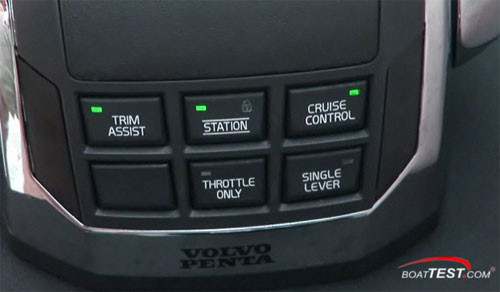 "Trim Assist"
"Trim Assist"This is the function I’ve just been describing. Push this button and system automatically adjusts the trim for you. You can still do it yourself, if you are so inclined. Just touch the button, the green light goes off, and you’re on your own just as you always have been, adjusting the trim with your thumb.
"Station"
This button activates the particular control unit where you are working. It is useful when you have multiple control stations, say, an upper and lower helm, wing controls, and another in the cockpit for backing down on a fish. Just hop over to that control and activate it by pushing "station."
"Cruise Control"
Cruise control is just as the name implies. It works like the one in your car. Set your speed and hit "cruise control" and you’ll maintain that speed. I know, you can do that now just by taking your hands off the controls, but you know it’s more than that. Just as you can make incremental adjustments in your car with the up and down buttons, so can you do it here. Are you following a boat and just slightly closing on him? Then hit the " - " button and you slow down a tad. Want to speed up, hit the " +" button and you accelerate a bit. You can hit +/- 5 times from where you have the throttles set. Beyond that, it’s time to move the controls and then start again.
These small incremental adjustments work at idle, too. So, if you are in a no wake zone and want a little more, simply tap "Cruise Control" and "+." Also, ergonomics weren’t lost on Volvo Penta designers. The throttles are so sensitive now (remember you’re not moving cables, just sending electric signals down some wires) that you won’t want to rest your hand on the throttle controls anymore. Something I am keen to do, so a little retraining was in order for me.
I very much like the fact that I could place my right hand on top of the base of the control unit between the two throttles. In that way my hand was ready for sudden action if need be, yet the weight of my hand and arm was not resting on the throttles which could be easily jiggled, especially when bouncing across waves. Now with my hand in this position, the “+” and " – " buttons are on the front of the unit, literally right at my fingertips. Brilliant!
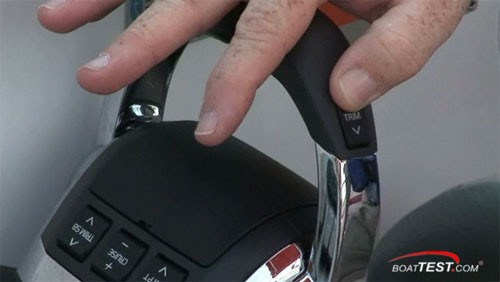 "Throttle Only"
"Throttle Only"Sometimes you still need to give the engines some gas to rev them with the boat out of gear. The old way was to push a button in at the side of the controls thereby putting the gears in neutral, so you could advance the throttle without moving the boat. With the new EVC system, you need only push the “Throttle Only” button -- a green light will come on signaling that it is engaged and the gears are in neutral -- and you can rev the engines.
"Single Lever"
Tired of always trying to get your two engines synchronized by manipulating one control, then the other while staring at the gauges instead of watching where you’re going? With the new EVC system that is ancient history. Touch the “Single Lever” button and now one engine control operates both engines simultaneously and two engines stay synchronized.
This naturally made me ask the big question… “So which lever did Volvo Penta decide would be the one you have to use?” As it turns out, they didn’t, you get to make that decision. Whichever control you move first, that’s the one lever that is in control and the other is the slave. Move the dead lever forward or reverse… nothing. When you get back in the vicinity of the marina, or mooring, or whatever calls for full control again, just move the two controls together and push the “Single Lever” button to deactivate. You now have two working controls again.
“Lockout”
Need to have the controls locked, for whatever reason. Just hold the “station” button in for three seconds and you’ll hear a series of “beeps”. Then the controls are deactivated completely. Now no one can hit the throttles when you’re not expecting it. Push the button to re-activate the controls and you’re off.
Digital Steering
We’re still not done. The steering is digital as well. The standard helm station is replaced with a digital control wheel and instead of cables and pulleys or hydraulic steering hoses connected to the wheel- -- the new EVC is translating and communicating steering instructions from the wheel to the drives by electrical impulses in wires. They send a signal to the steering servos that control the hydraulic rams to steer the boat. You no longer feel feedback in the wheel and all controls are fingertip gentle.
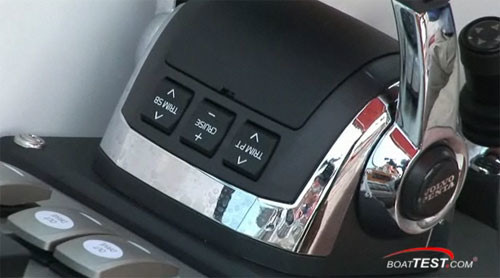 Sterndrive Joystick
Sterndrive Joystick Now that you understand how digital control works and can be so versatile, it’s a simple matter of adding a new controller input unit to the existing control system which has all been described above. A joystick can not only control your shifting, but steering and throttle, as well. Even better, it controls the steering of each outdrive individually and separately.
Add in a computer to correlate the steering, power, and thrust, to the movements of the joystick and you have complete maneuverability with outdrives. I tested this and it worked flawlessly. The Volvo Penta team even set up a pair of boats right up against the bow and stern of the my 31' (9.45 m) test boat and had me pull into that tight spot. Sure enough, I eased the boat right in without touching either vessel. You can see this for yourself in the "Sterndrive Joystick" test video.
The Display Screen
The info for all the engine and drive parameters is displayed on a 7” programmable LCD flat screen flush mounted to the dash panel. It gives graphic displays of all engine gauges and seriously de-clutters your panel. It’s also completely customizable, a fact that I appreciated as I have my own ideas of how I want information displayed and I was able to get what I wanted with just a few minutes of figuring out the nuances of how the programming works.
There was no manual handed to me, and it didn’t take long to use the single knob to turn and push my way through the controls to make whatever gauges I wanted to use, appear on the screen just where I wanted them. This is really the frosting on the cake.
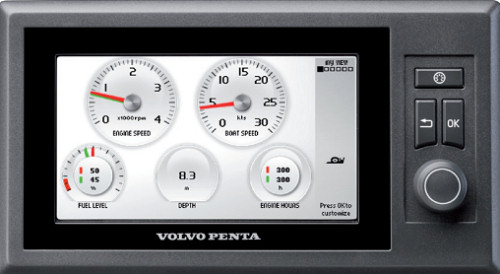
Here you have gauges positioned one way. Want to move that depth gauge over to the right position? No problem. Want to redesign the entire display? Can do.
By rotating your way through various screens you can get information on an assortment of parameters, most on a single screen if you choose, including;
• RPM
• Engine hours
• Coolant temperature
• Voltage
• Turbo pressure (diesel only)
• Oil pressure
• Warnings and alarms
• Trim position (sterndrive)
• Depth*
• Surface water temperature*
• Speed through water*
• Water tank level*
• Fuel tank level*
• Rudder position*
• Video camera**
* Requires extra sensor.
** Requires separate camera.
It’s all now at your fingertips, and it’s all the result of digital technology. And there’s more to come. Dynamic positioning, troll mode, dual speed modes… it’s all either here already or being developed along with more features that we haven’t even thought of yet. The future looks bright for digital technology, and the only question that remains is… are you onboard?